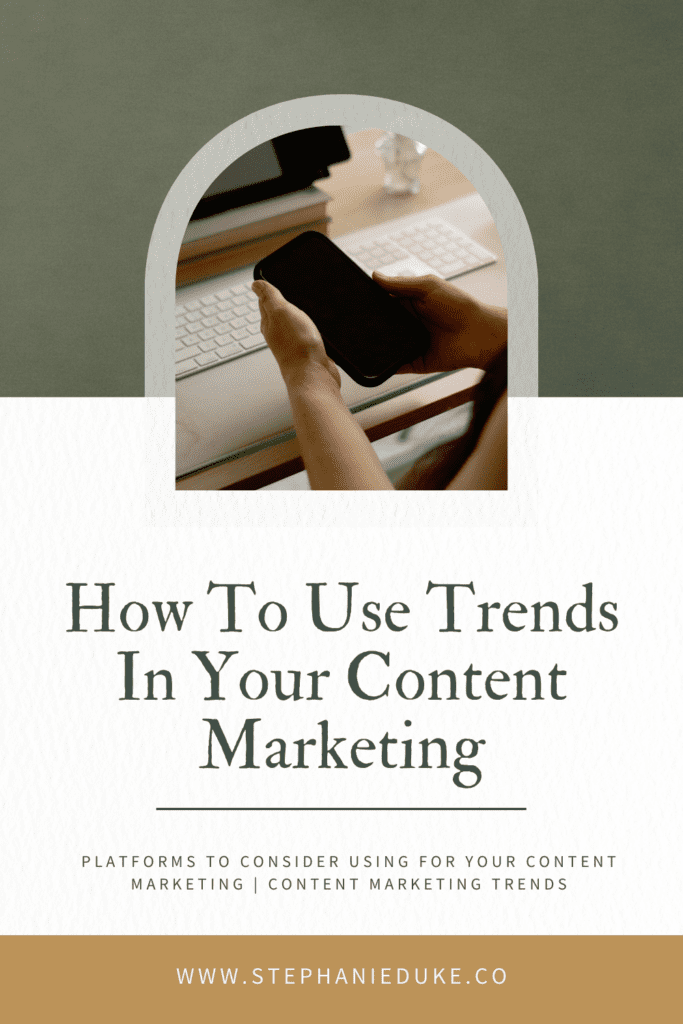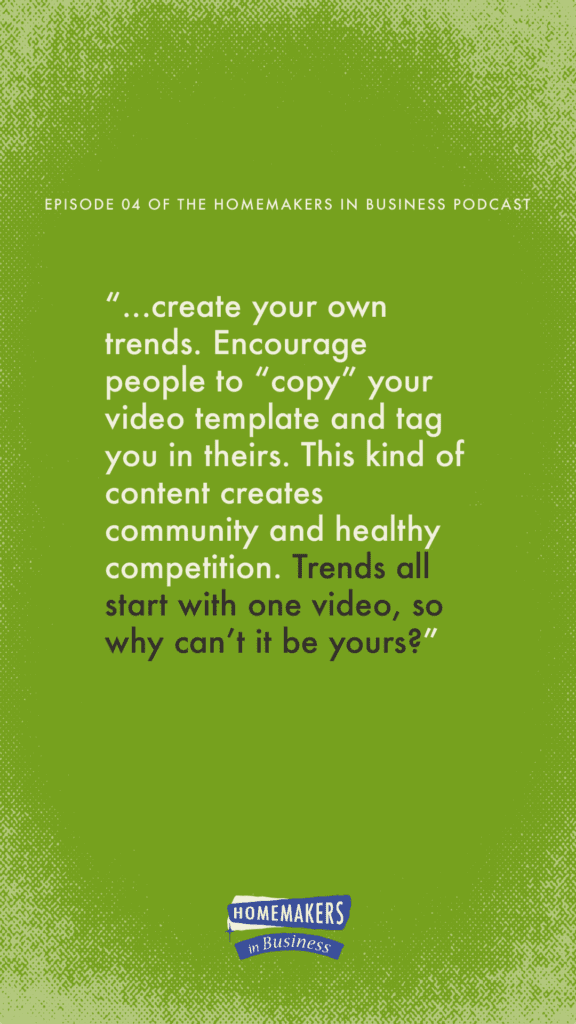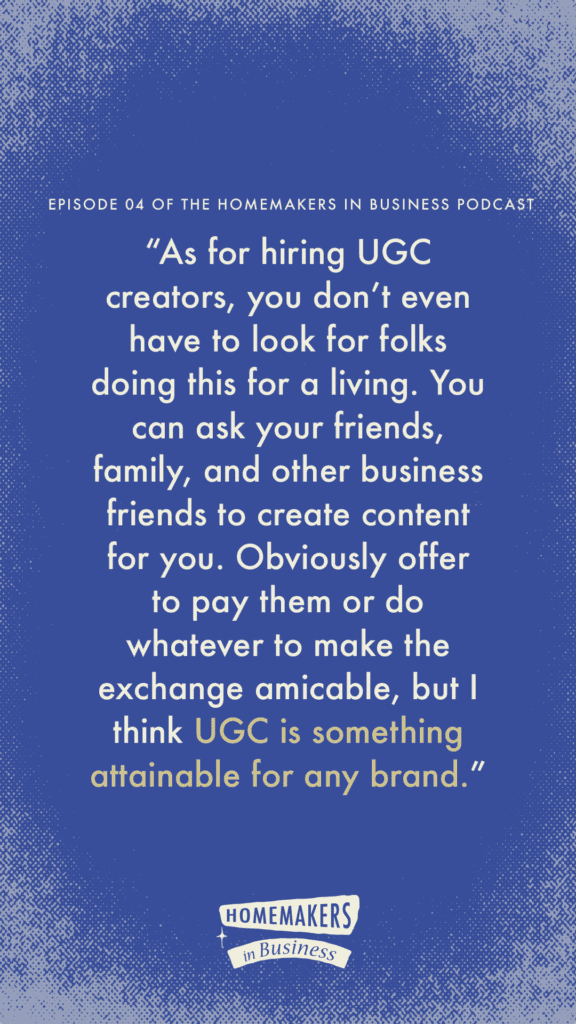How to Use Trends in Your Content Marketing: Part 1

I asked my audience on Instagram what topics they wanted to hear discussed on the podcast/blog and one of the overwhelming responses was how to use trends in your content marketing. This is a HUGE topic with a lot of information so I’ll do my best to break it down into bite-sized chunks. In fact, after outlining this it became pretty clear that I needed to break this up into 2 posts!
In this article, I’ll cover 2 sections:
- Platforms to consider using for your content marketing
- Content marketing trends
I’ll go over graphic design trends in the next article, How to Use Trends in Your Content Marketing: Part 2.
Defining Content Marketing and Trends
Before I get started, I think it’s important to define what content marketing is and what a trend is. According to Mailchimp, content marketing is a marketing strategy used to attract, engage, and retain an audience by creating and sharing relevant articles, videos, podcasts, and other media. And a trend, according to Vocabulary.com, is what’s hip or popular at a certain point in time. Pretty solid definitions, I think.
Although I would add, what makes content marketing different than traditional marketing and advertising is that it’s based on sharing value with your audience versus outright trying to convince them to buy from you. Content marketing will feel much more natural to your audience. It’s easier to warm them up to you this way so the purchasing decision is easy for them whenever it happens.
It’s worth mentioning that trends in general will apply to all businesses in different ways. I’ll mostly be speaking to service providers, educators, and other personal brands, but if you have a totally different business model you will still get some valuable content ideas from this episode.
Alright, are you ready to nerd out with me? Let’s go!

What platforms should you consider for your content marketing?
This is really going to depend on a few factors. Where your audience hangs out online, what you enjoy creating, and what you enjoy consuming. I think all of these are equally important because if you create content somewhere your ideal audience isn’t even at, you won’t make the sales you want, and if you personally don’t enjoy the medium you’re creating content in, then you won’t stay consistent with it.
So the first question to ask yourself is, who is your ideal audience? This is really getting into your brand strategy, but that truly should be the basis of all the decisions you make in your business. Knowing specifically who you want to serve is going to help guide your content platform, content medium, and the topics you cover.
You should strive to be a leading voice of authority in whatever your niche is. Now, I don’t believe you have to know your ideal client’s favorite color and what 3 items they’d bring to a desert island. But it is crucial to know some of their driving problems and desires in life, in regard to what you sell.
For example, I primarily target married millennial women who desire the freedom to run their own businesses from home while caring for their families well (aka ladies like myself!) Obviously, these women have a ton of other problems and desires, but that is what it boils down to for my ideal audience.
Okay, now let’s talk about what platforms you have to choose from.
You have social media, which includes popular options like:
- TikTok
- YouTube
You also have more traditional online content platforms, like:
- Blogs
- Websites
- Publications
- Emails
- Podcasts
- Apps
Now those last 2 aren’t really traditional because they are much newer than the others, but the difference between these platforms and social media is that you actually OWN the content on your website, email list, podcast, and apps you create. Social media is borrowed land.
Don’t get me wrong, it’s important, and you should be on at least one social media platform, but there have been several instances where Instagram has been down for a day. People’s accounts have been hacked or shut down for no reason. The algorithm sucks on basically all social platforms.
Primary Content Medium
So what do you do? Instead of choosing a social media platform as your primary content medium, choose something that you actually own. Then use that base content to create more content on social media to reach a wider audience.
If you aren’t already doing this, that may sound like a ton of work. And honestly, it is, but in my opinion, it is the safest bet to make sure your content is seen by the right people and that your hard work doesn’t just disappear.
Not to keep talking about myself, but I believe real-life examples are the best way to learn business concepts. I chose podcasting as my primary content medium in 2023 for a few reasons.
First, I own the content and control its distribution. It starts as a document on my laptop, gets recorded as an mp3 file on my laptop, then is uploaded to a distribution platform. The original content remains on my laptop forever. There is no chance of me losing it because I back it up not only to my Google Drive but to my hard drive and an external hard drive. If design school taught me one thing, it’s to back up your backups. LOL.
Second, the numbers are there. There are almost 500 million podcast listeners globally as of the beginning of 2023 and that number is continuing to rise. 68% of those listeners consume the whole episode. And the majority of those listeners are between the ages of 12 and 54, which includes my entire target audience and then some.
I could go on and on, but a quick Google search on podcast statistics will blow your mind. It simply made statistical sense for me to start a podcast (If you haven’t yet tuned in to the Homemakers in Business podcast, click here to listen).
Third, I talk to myself A LOT during the work day. I work from home by myself, with only my dogs and cats to keep me company. So naturally, I talk my poor husband’s ear off about work things he’s not interested in when he gets home in the evenings. Podcasting gives me a fun outlet to talk business with a wide audience.
There are so many other benefits. I’m improving my speaking skills, my writing skills, and my teaching skills. These are those soft skills you don’t think about much once you’ve got the hard skills like design principles and software down pat, but they are equally important to actual client and business relationships.
Fourth, I enjoy podcasts. That is how I consume the majority of my content throughout the day. Yes, I love reading blogs, getting exciting emails (get my monthly newsletter here!), and watching videos, but podcasting is just so easy to consume as a homemaker in business.
I can listen to podcasts while I’m washing dishes, folding laundry, working out, cooking dinner, driving, working in the garden, and taking care of the chickens. It allows me to learn and be entertained without having to look at a screen. I don’t know about you, but when I’ve been working on my laptop for hours, I don’t want to spend my leisure time staring at more blue light. I want to be living in the real world, while simultaneously not falling behind on professional and personal development. I have a feeling you’re the same way, and that’s why I created a podcast for you.
So hopefully that gives you a starting point for deciding what will be your primary content platform. This isn’t to say you can’t also have a blog and a website and 3 social media channels. In fact, I’m going to say you can choose any and as many of these platforms as you want, but you should always have a website. It should act as the hub for all your other content, as well as be where clients and customers actually buy from you. I won’t get on my website soapbox today, but just know it’s super important.
Choose Your Primary Content Platform and One Social Media Platform
My recommendation would be to choose your primary content platform that you will own the content on plus one social media platform. Get really good at producing consistent content on that platform before adding another one. Now, I personally consider Facebook and Instagram to be the same platform in this regard, but that’s because my audience on each platform is totally different. Sure, there’s a handful of overlap, but for the most part, I can post the exact same content on both channels and get engagement from totally different people.
What you should do will depend on your own ideal audience, where they hang out the most, and where you like hanging out the most. Do a little market research to make your decision.
Give TikTok a Shot
One last note on choosing your social media platform. Unless you’ve been living under a rock, you know TikTok is the still the hottest thing since sliced bread. If you are brand new to business or have not seen great success on other social media platforms even with consistent posting, I’d recommend considering TikTok. It has over 1 billion users so it is HIGHLY likely that your ideal audience is hanging out there. As we’ll discuss in the next section, TikTok is not just full of silly dancing teenagers anymore.
According to Canva, TikTok videos, Instagram Shopping, live streaming, and UGC (user-generated content) are the key content formats to focus on in 2023.
Content Marketing Trends
You’ve chosen your primary content platform and your primary social media platform. Congratulations! Now we can start talking about content marketing trends. For March 2023, when I’m originally writing this, here’s what’s hot in content marketing.
- Short-form video
- AI (artificial intelligence)
- Influencers and UGC (user-generated-content) creators
You probably expected short-form video, maybe even AI, but you may be wondering what the heck I mean by UGC. We’ll get deep into it all in just a moment. But first, I want to clarify that this is not a definitive list or even one that you can find replicated on elsewhere on the internet.
These current “trends” are practices that I believe are going to continue to grow over the next several years rather than be replaced.
Short-Form Video
Made popular by TikTok and picked up by other major social media networks like Instagram, Facebook, and even YouTube, this generally refers to vertically composed videos that are less than 60 seconds long. With people’s shortening attention spans, it’s really no wonder that this content medium took off like it did.
It’s super easy to consume a lot of information or entertainment quickly in short bursts throughout the day or in an hours-long binge sesh. It can really become quite the time-suck for folks, and while I don’t love that, your business might as well benefit from it. People are gonna indulge in it anyway.
And I guarantee if you participate in this here-to-stay trend, your biz will benefit from it somehow. Here are some fun stats to convince you:
73% of consumers prefer short-form video to learn about a product or service
89% of people say watching a video has convinced them to buy a product or service
95% of marketers say video marketing has helped them increase brand awareness
87% of marketers say video marketing has helped them increase sales
91% of people say they want to see more online videos from brands in 2023
51% of people are more likely to share video with their friends than any other type of content
These stats came from Wyzowl, who has fascinating findings on video marketing in this PDF. Check that out when you get a chance.
How do you actually apply the trend of short-form video to your own content marketing strategy?
Much like everything else, this depends on your specific business and your specific ideal audience. If you don’t know this already, you should be creating content for the audience you want, not necessarily the audience you have. This is important to remember especially if you are pivoting your offers or you’re just getting started and your only existing audience is your family and high-school friends.
Let’s talk about trends within the trend. Short-form video itself is a trend, but one that’s here to stay. Short-form video trends, however, are constantly changing. Like daily. I could not possibly cover what is actually relevant right now as you’re reading this.
Instead of trying to, I’m going to provide you with some resources that actually keep up with trends by the month and some even by the week. This will hopefully give you a more accurate, up-to-date view of TikTok and Instagram short-form video trends.
Short-form video trends resources:
You don’t have to look at a blog to discover video trends. You simply just need to browse the apps. You probably already do this, but do it more intentionally and pay attention to what you see repeated over and over by different creators.
How have different industries used the same sound byte? How can you make that fit your own unique niche?
For example, if you’re a homesteading educator and you see a fashion influencer using a particular song in an outfit of the day video, you could use that same song to show your canning process.
Create Your Own Trends
I would recommend never copying a trend tit-for-tat, but instead making it your own. This may feel difficult when you first start, but after a while, you’ll start getting inspired by all these other interesting industries besides your own which means you’ll be creating more unique content that people are less likely to have already seen from a competitor.
Even better, create your own trends. Encourage people to “copy” your video template and tag you in theirs. This kind of content creates community and healthy competition. Trends all start with one video, so why can’t it be yours?

Here’s my last comment on short-form video. Don’t feel like you have to follow the trends. If you don’t want to dance on camera because you don’t like dancing, then don’t do a dancing trend video. If you think pointing at words on your screen is silly, don’t do it. Trendy videos do have a higher chance of going viral, but virality is not the point of your creating content. You want to be seen as an authority in your industry, whatever that industry is. Travel, art, hospitality, copywriting, photography. Find your own groove within that niche and own it. Your audience will get a kick out of your take on video trends, but they will stick around for your unique voice in your space.
AI (artificial intelligence)
Now, I don’t know about you, but whenever I hear the term AI I think of I, Robot with Will Smith and get the heebie-jeebies. Hollywood did us no favors in preparing us for an AI future. I have lots of mixed feelings about this.
Realistically, we’ve been using AI in some form since the 50s, but it’s just been in the last decade or so that it’s started to feel like that futuristic-humanoid-robot AI we’ve all seen in the movies. I am really not that well versed in the ins and outs of AI yet, and I don’t know that I ever will be, but there are some interesting programs out there that I think are worth checking out if only for curiosity’s sake.
Like I said earlier, these so-called “trends” I’m covering I don’t believe are actually trends anymore, because they are only going to continue to grow exponentially over time. But these are the particular programs that are trending in popularity as of March 2023:
Obviously, there are others, but these are the 4 I’ve seen in action the most.
ChatpGPT
ChatGPT is a natural language processing tool that you can have human-like conversations with in a chatbot format. It can answer questions, learns from the conversation, admits its mistakes, challenges incorrect premises, and rejects inappropriate requests. The way I’ve used it, I’ve found it to be helpful in outlining content like emails and blog articles, generating unique podcast topic ideas, and brainstorming when I’m in a creative rut.
It feels like a really, really advanced Google search. It’s probably my favorite AI tool I’ve tried out simply because it’s so quick and doesn’t feel icky. I don’t know how to describe it super well, haha. Now, it’s not perfect and I would NOT recommend it for any type of research because the data it provides is not always accurate. However, I can see this particular AI tool getting pretty advanced pretty fast.
DALL-E 2 and Canva’s AI Text to Image Converter
Now Dall-e is an AI system that can create realistic images and art from a description in natural language. Basically, you write a prompt and the system produces an image that matches it. I’m not a super techie, so don’t ask me how it works, but it is wild what it can produce.
Canva’s AI text to image converter is basically the same thing, just through Canva. There’s a lot of controversy at this time concerning the legality of these images. Some folks believe the images are ripping off existing art, others believe it’s 100% created by the AI system. I don’t know. I don’t know how we can know. But there are loads of brands already using these systems to create visual content for their brands. It’s worth playing around with and seeing how you feel about it. If nothing else it would be great for creating some unique background imagery for your website and social media posts!
Lensa AI
Lastly, Lensa AI. This is one I haven’t personally used. It is described as an all-in-one image editing app that can take your photo and turn it into different art styles. You’ve probably seen half your Facebook friends doing this. Much like Dall-e, there’s some controversy on the legality of these images. Test it out and see how you feel about it! That’s really all I have to say about this one.
Recapping AI
I still don’t know how I feel about these programs. I think there are plenty of existing AI tools that are super useful – hello Grammarly and Adobe Sensei. But this stuff that is trying to take the place of human creativity… I just don’t know. I included it because it’s unavoidable. It is a part of our world now, whether we like it or not. So I wanted to give you the opportunity to check these tools out if you haven’t yet.
I do think ChatGPT has a lot of safe and useful potential as it is, as long as you’re using it responsibly and with common sense.
Influencers and UGC (user-generated-content)
This is a bit of a big topic on its own. We’ve known about influencers for years. But UGC creators are kind of new to the playing field. Let’s define both.
Influencer
An influencer is someone who is paid, sometimes directly and sometimes through affiliate links, to take photos and videos of products and share that content with their followers. Their contract will state how many times they have to post the content, what times, and dates, and sometimes what they have to say. They are called an influencer because they have the ability to influence their audience to buy that product from them.
The value of an influencer isn’t necessarily in the size of their audience but in their distinct niche and the engagement level of their audience. AKA their audience’s willingness to buy from them.
Typically influencers have built a personal brand for themselves based on their knowledge of a specific topic such as travel, homesteading, or holistic wellness. They often gain their following through blogging, YouTube, podcasting, and/or social media. Really most influencers work through social media now.
UGC Creator
By comparison, UGC creators can create the same type of content as influencers, but it is more organic and they give the brand they’re working with the rights to their content. Some UGC creators will accept free product in exchange for their photos and videos, while others will be paid, and others still will want free product and to be paid. It simply depends on the creator.
UGC is created naturally by your clients and customers for instance when they create a face-to-camera Instagram Story raving about their experience working with you or using your product and they tag you in it. If you’re tagged in the content then you have full rights to reshare that to your Stories. This of course applies to other social media mediums as well.
However, if a client or customer shares about their experience with you and does not tag you in it, you need to ask permission to share that content in your own marketing.
You can hire UGC creators just like influencers, but they each serve a different role. UGC creators help you create content to use in your own marketing, while influencers help you reach a wider audience with their content. It’s like the difference between renting and owning a house. You’re renting the influencer’s content for a limited time and buying the UGC creator’s content.
There are lots of ways you can use influencers and UGC creators in your content marketing strategy! This is ideal for product-based businesses, but it could work for service providers too. Either way, you likely won’t be looking at mega-influencers unless you yourself are a mega-brand. What will probably be most effective for you are micro-influencers. People who have a really solid position of authority in a very niche market.
Ask Your Friends and Family for Help
As for hiring UGC creators, you don’t even have to look for folks doing this for a living. You can ask your friends, family, and other business friends to create content for you. Obviously, offer to pay them or do whatever to make the exchange amicable, but I think UGC is something attainable for any brand.

I will cover graphic design trends in the next following article, How to Use Trends in Your Content Marketing: Part 2.
To recap part 1 of How to Use Trends in Your Content Marketing, we talked about platforms to consider using for your content marketing and actual content marketing trends. The trends I discussed were short-form video, AI (artificial intelligence), and influencers and UGC creators (user-generated-content).
There was a lot of technical jargon so if you have any questions about these topics feel free to DM me on Instagram @stephaneiduke.co.
If you enjoyed this article, I encourage you to check out the Homemakers in Business podcast where I talk about branding, websites, marketing, and entrepreneurship. I am eager to continue growing this show and the community around it, so I would be very appreciative if you left me a rating and review on Apple Podcasts!
I’m Stephanie, but you can call me Steph!
I design brands & websites that get you butterflies-in-your-stomach-excited about your business again.
Simply put, I’m a graphic designer that specializes in brand identity design and Showit website design - arguably the most important aspects of your business! I live in central Alabama with my high school band directing hubby, Thomas, on our modest homestead in the country.
your guide to a stress-free website
FREE Website Planning Tool
- My exact Website Copy Planner Google Doc
- A master doc for keeping track of links and embed codes
- Loads of tips and tricks for planning website content (copy, photos, branding, etc) with ease